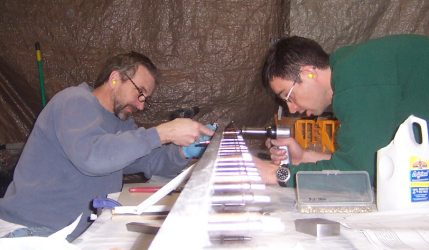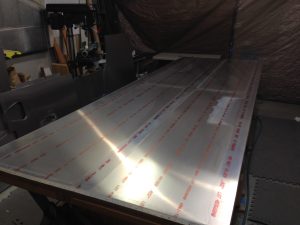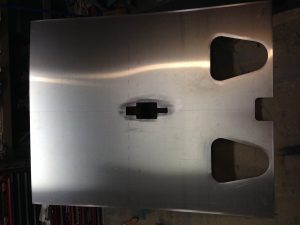12/30/2013
Deburring left wing
I spent the remainder of last night with mind numbing deburring of the left wing components. I would like to say I am done but I only spent a couple/three hours at it and part of the time was spent with final trimming of the root doubler. The total time I have spent deburring ( which is mostly sanding the drilled holes with 150, 220 and then Scotch Brite ) is not trivial. I’m not sure if I am over doing the process. Part of the work is in preparation for a thin coat of self etch primer and the alternative is to simply use a deburring tool for holes and edges. I find the deburring tools still require sanding to smooth the edges and the end result is that, as noted, sanding is the preparatory step for priming. I have used a lot of sand paper….
This entry is really just a stalling effort as I wait for the shop area to warm up. The outside temperature dropped to -16 overnight and so while it is certainly warmer in the garage shop it is not near any temperature that would be considered comfortable without a coat and gloves.
My plans for today are to get as close as possible to priming the skins. As I think about that statement it is really deburring and dimpling. Some of the gussets need to be updrilled and riveted and the bell crank needs to be disassembled oiled and reassembled. Compared to the debur and dimple tasks these little side tracks are hardly worth mentioning.
So, the outside temperature just ticked up to -15F and the shop is probably starting to warm a bit and it’s time to think about the tasks ahead (the air temp is no doubt warm but everything in the room sucks the heat out of you as you touch it or even stand next to it until the heater has time to warm it all up).
My guess at timing:
Deburring ribs 10 min each x 26 gussets = 260 min
Deburring skins (leading edge is done) 45 min x 2 = 90 min
C.S. and debur main spar 120 min
Dimple all parts 120 min
Priming all parts 90 min
Bell crank assembly 30 min
Final assembly and riveting wing 240 min
Total time~ 16 hours
It is close but I can finish before we leave for our planned New Year’s Eve festivities. I need to try to accelerate the process so I can begin priming by tonight as even with the exhaust fan running the room is uninhabitable without a mask as the primer dries. It is a good idea to prime at the end of the day to let it sit overnight.
Update at the end of the day.
I overlooked a handful of small things with my list above. I have no pictures for today as taking things apart and deburring just does not justify any. I think I’ve put in about 10 solid hours in the plane today, nearly all of it sanding aluminum to debur and I am probably only 1/4 the way to finishing ( that would mean assembling and riveting the wing). So at this rate I will finish before Sunday but that is about all I can hope for. I will have to settle for that and just be satisfied with two well built wings hanging in my garage while I am away in Singapore beginning next week.
Return To Left Wing Assembly




















































